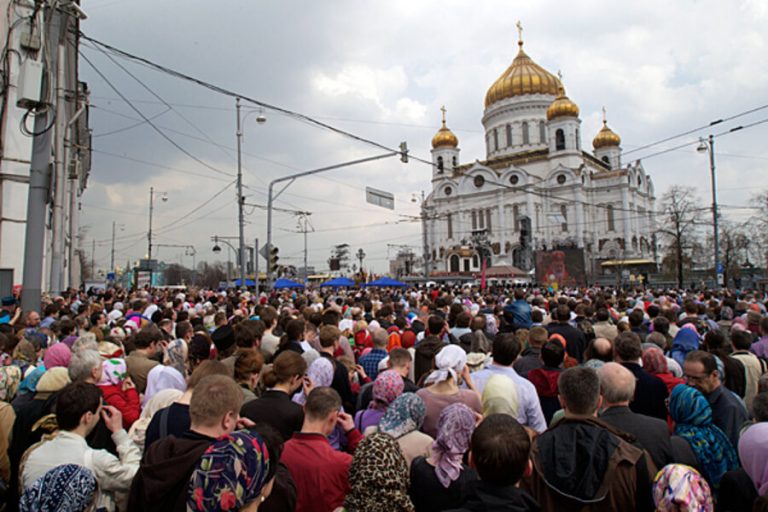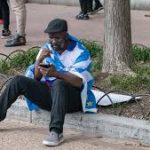Putin’s regime keeps building a paradigm where the Orthodox Church and the state play one tune. Representatives of the security services are infiltrated in the clergy; the church opposition and internal movements differing from the official position are under strict control; the church influence on all key social processes is gradually increasing. The Kremlin went back to the pre-revolutionary Russian model when the state leader post was consecrated by the church, and the church structure itself was under the autocrat’s thumb.
The Orthodox Church in today’s Russia is not a system functioning in the civil society parallelly with the state. It is neither ‘state within a state’. The Russian Church is the very state that has controlled freedom of religion and uses the church to take up its matters.
Functioning to introduce ‘any power from God’ ideologeme to stabilize the regime
The Orthodox Church fits completely in the national-conservative paradigm being formed in Russia at the present time. The state and authorities become sacred and inseparable from God’s will. Any state system in Russia is set up by God. By using the Orthodox Church the Kremlin is trying to ensure its support and subordinate the population.
The principle expressed in the words ‘Let everyone be subject to the governing authorities, for there is no authority except that which God has established. The authorities that exist have been established by God. 2 Consequently, whoever rebels against the authority is rebelling against what God has instituted, and those who do so will bring judgment on themselves’ (Romans 13:1-2) is implanted among the population and is taken literally. Therefore, the political system is stabilized, dissent among the believers is neutralized. Under this strategy the Orthodox Church extends its influence and the number of people seeing the church as the mentioned dogma rather than the Christian canon is increasing.
Since, ideologically Russia is reviving the Soviet Union, a mismatch conflict between the church and state unity in today’s Russia and break with this unity tradition in the Soviet era arises. The Kremlin resolves this conflict in the style of totalitarian practices by misinterpreting history and creating new myths. For instance, let us take an icon ‘Blessed Matrona blesses Joseph Stalin’. It features Saint Matrona of Moscow (1885-1952) and Joseph Stalin known as an anti-Christianity fighter. The icon shows Blessed Matrona blessing Stalin to defend Moscow during the World War II. Despite the fact that the appearance of the icon at the beginning of the 21st century found a negative response, including in the Orthodox Church itself, the myth is developing and, in its turn, creating a ‘bridge’ between the Russian Orthodoxy most cruel persecutor and modern Orthodoxy. Therefore, the effect of the ‘state-church’ connection continuity, even during Stalin’s regime, is achieved.
The ideologeme that the Communist and Christian moral and ethical concepts are the same and their difference lays only in the manifestation has become widespread. As Mr.Putin says, ‘Actually, Communist ideology is very akin to Christianity. Freedom, brotherhood, equality, justice – all this inherent in the Holy Scriptures, everything is there. As for the code of the Communism builders, this is sublimation; a primitive extract from the Bible. They invented nothing new’.
In addition, the Kremlin is also cultivating ‘sergianism’ traditions, the Orthodoxy trend based on the Orthodox Church loyalty to the Soviet regime, in the current conditions, any rule. As a result, the clergy who disagrees with such realties and trends, and accuses the modern ROC of neo-Sergianism, has to oppose and become schismatics.
There are Russian Orthodoxy movements that see the acting government as devilish and jeopardizing the greatness of Russia. They actively use the ideologeme ‘Moscow is the third Rome’ (modern Russia’s monopoly on Orthodoxy) and ‘the good must be with fists’ (support for violence against dissents). A lot of followers of this movement support absolute monarchism in Russia and the Russian Empire’s revival within the pre-revolutionary borders. The movement supporters often back Russia up in its aggression against neighboring countries and participate in military actions. In a meantime, there are widespread expectations of a new messiah, a tsar, who will glorify Russia. However, this point of view is not official; it’s mostly shared by the ROC representatives.
The activity of Russian Orthodoxy ‘combat wing’ is controlled by the Russian security services. In this way they manage both to control the radical wing of Russian Orthodoxy and form a totalitarian sect that can be potentially used in armed conflicts and become more active in case of appearing a new totalitarian leader in Russia.
Functioning to establish a freedom of religion monopoly
In case of monopoly all alternative Christian denominations, such as Catholics and Protestants, face difficulties in Russia. The reality of today’s Russia is characterized by visa refusal for the Catholic clergy, problems in solving administrative issues, prohibition of Jehovah’s Witnesses, criminal prosecution and torture of Protestants, and restriction of the foreign preachers’ activity. This very policy is aiming at monopolizing Christianity and establishing special services’ control over all Christian cults.
The situation with other religions is different. The Kremlin uses another approach here. In national republics where other beliefs are widespread the policy is more moderate. The representatives of special services are also infiltrated in the environment of the ministers of such religious cults. This is especially true of Islam. If the indigenous people do not prevail in the population of the administrative unit of Russia, and the national elites are weak, the Orthodox Church expands.
Functioning to create an ‘exclusiveness’ image of the Russian people and cultivate a mystical consciousness
Today’s Russian Orthodoxy is being transformed significantly by getting more politically engaged and socially active. The authorities are actively introducing the ideologeme on ‘exclusiveness’ of the Russian Orthodox Christians who are identified with the Russian people. It gives an opportunity to use the technology of opposing ‘correct’ Orthodox and the rest. Every year the emotional portrait of ‘the rest’ is more and more negative, aggressive and harsh.
Therefore, the Kremlin is implementing the ideology of the ‘chosenness’ of the Russian people and their worldwide mission. If this policy continues, we do not rule out a massive spread of ‘Russian Orthodox fascism’; in some branches of Orthodoxy we see how it has already started.
The Kremlin’s another goal is to cultivate a ‘mystical consciousness’ among the population. This action completely outlines the tendencies for the totalitarianism strengthening in Russia. Deification of politicians and statesmen as ‘saints’, lack of understanding of cause-and-effect relationships in the social sphere and the economy, sacralization of the state and power – these are the key directions the unity of state and the church is currently co-working on. Active attempts to involve children in the official Orthodox Church on the basis of schools prove the long-term nature of these intentions. The ultimate goal is likely to transform Orthodoxy in Russia into an eclectic belief of a totalitarian nature.
Functioning to influence geopolitically
The identification of the categories ‘Russian people’ and ‘Orthodox people’ plays an important role in influencing geopolitically. In fact, the ROC is one of the important links in the ‘Russian world’ concept: the territory that originally belongs to Russia but is temporarily ruled by non-Kremlin representatives, and will go back to its control sooner or later.
On the territory of the post-Soviet area the ROC is used as a structure performing the following tasks:
– dissemination of information in the interests of the Kremlin, and public opinion formation,
– support of pro-Kremlin political projects,
– collection of information and high-ranking politicians and successful businessmen recruiting,
– formation of paramilitary organizations and support of military conflicts in the interests of the Russian Federation,
– traffic of illegal goods, including weapons, and literature.
The ROC has the greatest influence in Ukraine, Belarus, Moldova and Latvia. Taking into account the tasks, the ROC clergy, in fact, works on the territory of neighboring states as security services, controlling an extensive network of active or passive groups that cover the whole territory the country.
Functioning to get profit
One of the main goals the Kremlin elites pursue is personal enrichment and creation of favorable conditions for long-term enrichment.
In this case the ROC plays one of the key roles.
The Orthodox Church is an economically active organization whose billion-dollar revenues are virtually impossible to calculate. The main income sources are donations, budget funds, ceremony fees (mainly, commemoration), as well as legal business (tourism, food production, clothing, jewelry, alcohol, furniture, building services, agriculture, etc.) that in many cases is tax-free or with tax benefits. Taking into account the fact that the clergy of the Orthodox Church is closely connected with the security services and the government, the ROC is one of the most important channels for getting profit for the Russian elites. The creation of an eclectic belief of a totalitarian nature based on Russian Orthodoxy is one of the most important parts of the strategy of the Kremlin elites in the context of preserving power and personal enrichment conditions. In conclusion, one can predict:
• the ROC further isolation up to proclaiming itself as the only true Christian religion
• further prohibition by the state of all alternative Christian beliefs in the Russian Federation,
• policy towards the closed Russian socio-political system and the final and irrevocable establishment of a totalitarian society in the Russian Federation.
In this context, Russia will obviously use the experience of China in creating the Chinese Patriotic Catholic Church.




